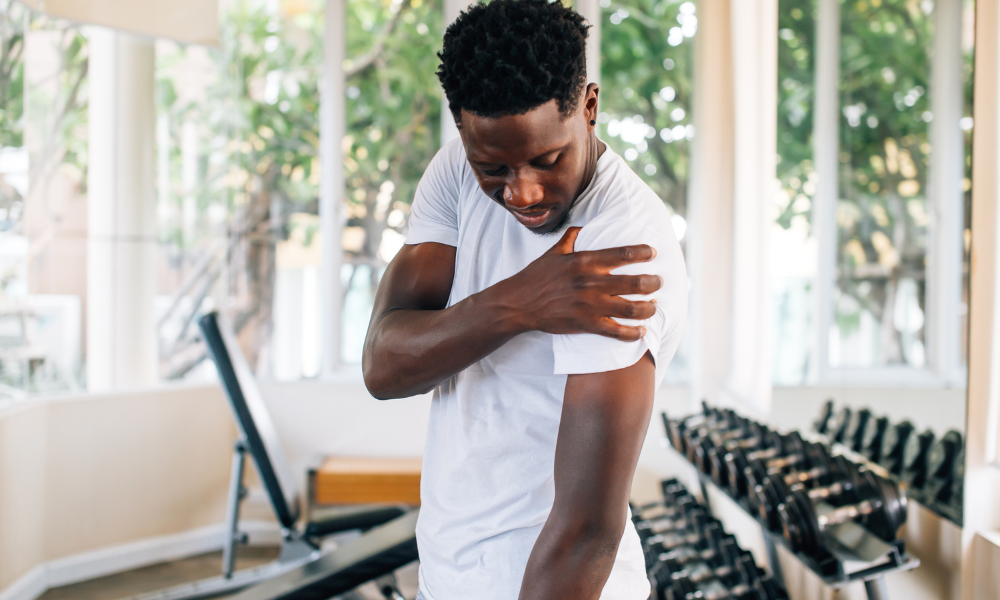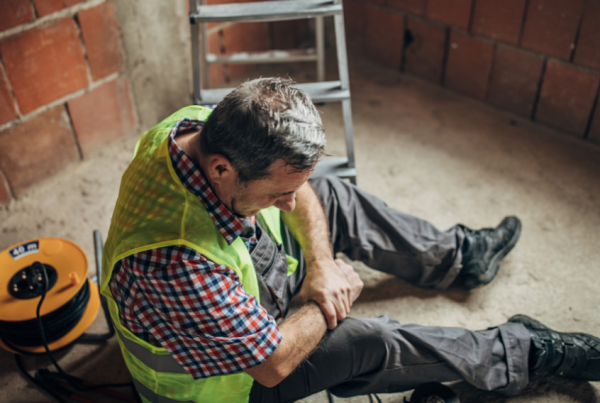Shoulder Pain
Move Better. Live Fuller. Your Wellness Journey Starts Here.
Schedule a FREE Discovery Call!
About Shoulder Pain
The shoulder is one of the most mobile areas of the body, and has a complex structure involving multiple joints as well as many connecting muscles, ligaments, and tendons. Due to this complexity and wide range of mobility, the shoulders are very prone to dysfunction or pain.
Pain in the shoulders can range widely. It may be anything from mild to severe, and in some cases may radiate down the arm. Pain may be constant, or only occur with movement.
Shoulder pain can feel dull, sharp, throbbing, or achy. It may be accompanied by popping or cracking sensations during movement, and can disrupt shoulder function. Depending on the cause, shoulder problems can involve other symptoms such as:
- Stiffness
- Weakness
- Instability
- Numbness
- Swelling
- Tenderness
- And more

What Causes Shoulder Pain?
The shoulder is made up of many complex structures, and there are a lot of factors that can cause dysfunction and pain in these structures. Although the shoulders allow for a lot of movement, overuse or repetitive movements can create problems. This is common for people who play sports or who repeat the same movements often in their careers.
Poor posture can also significantly contribute to shoulder problems. Prolonged sitting, hunching, slouching, and forward head posture can put strain on the shoulders. Poor posture can pinch nerves and create friction within the shoulder’s structures, causing additional symptoms.
Other common causes include injuries, nerve problems, tendon inflammation, age-related wear, and other conditions. We’ve outlined some common types of shoulder conditions below:
Rotator Cuff Injuries
The rotator cuff is a group of muscles and tendons that surround the shoulder joint and allow for movement and rotation. Problems with this structure are very common, and usually involve strain or inflammation of the tendons. These problems can cause weakness, reduced mobility, and pain.
Impingement
Impingement is another common shoulder problem, especially for athletes or those who make repetitive movements. It occurs when soft tissues within the shoulder such as tendons are pinched or compressed by bone, often due to swelling or inflammation of the tendon. This can make shoulder movements painful.
Bursitis
This refers to inflammation of the bursae, which are fluid-filled sacs found in joints that cushion bones and soft tissues. Bursae typically prevent friction between these structures, but overuse of the shoulder can cause bursae to become inflamed and painful.
Arthritis
Arthritis of the shoulder refers to degenerative changes in the joints that often occur with age, such the breaking down of cartilage. Arthritis can lead to pain, stiffness, and a reduced range of motion.
Frozen Shoulder
This is a condition characterized by stiffness and painful movement. It is caused by stiffness of the muscles, ligaments, or tendons that surround the shoulder joint. This stiffness usually occurs in situations where the shoulder is kept immobile for a period of time, such as after a surgery or injury to a part of the arm.
Tendonitis
Tendonitis is inflammation of tendons, which connect muscle to bone. This most commonly occurs to the rotator cuff tendons, but can affect the bicep tendons with overuse. This is known as biceps tendinopathy.
Instability
The shoulder is primarily a ball and socket joint. When the ball portion of the joint is loose in the socket, it can cause instability and pain. This often occurs due to an acute injury, but can be a chronic condition as well.
Scapular Dyskinesis
This condition describes abnormal positioning of the scapula during movement or while at rest. The scapula plays an important role in shoulder movement and rotation, so problems with this structure can cause reduced mobility and pain.
Labral Tears
The shoulder labrum is a cartilage structure that supports the ball and socket joint. Problems with the labrum can cause instability and pain. The most common types are the SLAP tear and Bankart tear.
Other
Other problems with the shoulders can include:
- Fractures, such as from falls or impact.
- Nerve compression such as thoracic outlet syndrome, which can cause numbness and pain that radiates down the arm.
- Shoulder sprains, which are common injuries of the tendons that can cause pain and swelling.
Physical Therapy for Shoulder Pain
Many causes of shoulder pain are musculoskeletal, meaning physical therapy is a fantastic choice of treatment for practically any shoulder issue! The providers at Hive Therapy and Wellness curate individualized treatments for every patient they see, meaning your treatment plan will be formulated based on your individual condition and needs.
The process will start with an evaluation and examination, where your physical therapist will discuss your medical history, past surgeries or injuries (such as sports injuries, work injuries, etc.), and symptoms. They’ll examine your shoulder for swelling, tenderness, range of motion, and dysfunction. Once they have narrowed down some possible causes of your condition, they’ll create a care plan based on your needs. The treatments included in this care plan can include methods such as:
Pain Management
Whether you have shoulder pain from an injury, inflammation, or a specific condition, physical therapy can provide significant pain relief through a variety of treatments. The physical therapists at Hive Therapy and Wellness provide treatments such as electrical muscle stimulation, temperature therapy, and many forms of manual therapy.
Manual therapy refers to hands-on treatments that manipulate and mobilize your tissues, including muscles, nerves, tendons and ligaments. Manual therapy treatments relieve tension, improve function, and reduce pain. They can also be used to address problematic scar tissue, such as for patients with previous surgeries or injuries. Some examples of manual therapy include cupping, tissue scraping, dry needling, and more.
Neuromuscular Re-Education
Treatments such as neuromuscular re-education and biofeedback restore normal movement patterns and coordination, especially after an injury or surgery. These treatments are essential to regaining optimal function and movement to the shoulder after these instances.
They can be helpful for patients who have inefficient movement patterns, which may contribute to poor posture or injury from repetition. Neuromuscular re-education improves your function and coordination, allowing you to move with optimal form and without pain.
Strengthening and Stretching
To encourage better form, flexibility, and function, your physical therapist will curate an exercise and stretching routine for your individual needs. When muscles are weak and tight, they can create strain and friction that may cause shoulder pain. Strengthening the shoulders and surrounding muscles allows the shoulder muscles to move and coordinate as needed for sports, activities, and daily movement.
Your exercise plan will not only look to strengthen your shoulder muscles, but also your back, core, and arm muscles as needed—as many of these related muscle groups support the shoulders, and may inhibit movement if stiffness or weakness is present.
Correcting Posture and Form
As mentioned before, posture has a significant impact on shoulder health. This can include standing posture, sitting posture, your posture during daily movements, and your form while playing sports. Your Hive physical therapist will be able to examine your posture or form and identify areas of weakness.
Based on your individual needs, they’ll lead you through exercises, therapeutic activities, spinal manipulation, and other forms of treatment to correct your posture and to encourage optimized movement. This may require strengthening or treatment in other areas of the body, as your posture is significantly affected by your back, hips, core, and pelvis.
While the above-mentioned treatments are good examples of what you can expect in the clinic, they may not be the only forms of treatment you receive. Hive Therapy and Wellness is dedicated to comprehensive, individualized treatment—meaning you can enter our clinic expecting a plan of care that is unique to you and your needs. Our physical therapists will use the best choices of treatment to address the root cause of your shoulder pain, which could include any of the following methods:
- Neuromuscular re-education
- Manual therapy
- Exercise prescription
- Dry needling
- Cupping
- Tissue scraping
- Behavioral modifications
- Therapeutic activities
- Electrical muscle stimulation
- Spinal manipulation
- Therapeutic modalities
- Biofeedback
The shoulder is one of the most mobile areas of the body, and has a complex structure involving multiple joints as well as many connecting muscles, ligaments, and tendons.
Due to this complexity and wide range of mobility, the shoulders are very prone to dysfunction or pain.
Pain in the shoulders can range widely. It may be anything from mild to severe, and in some cases may radiate down the arm. Pain may be constant, or only occur with movement.
Shoulder pain can feel dull, sharp, throbbing, or achy. It may be accompanied by popping or cracking sensations during movement, and can disrupt shoulder function.
Depending on the cause, shoulder problems can involve other symptoms such as:
- Stiffness
- Weakness
- Instability
- Numbness
- Swelling
- Tenderness
- And more
The shoulder is made up of many complex structures, and there are a lot of factors that can cause dysfunction and pain in these structures.
Although the shoulders allow for a lot of movement, overuse or repetitive movements can create problems. This is common for people who play sports or who repeat the same movements often in their careers.
Poor posture can also significantly contribute to shoulder problems. Prolonged sitting, hunching, slouching, and forward head posture can put strain on the shoulders.
Poor posture can pinch nerves and create friction within the shoulder’s structures, causing additional symptoms.
Other common causes include injuries, nerve problems, tendon inflammation, age-related wear, and other conditions. We’ve outlined some common types of shoulder conditions below:
Rotator Cuff Injuries
The rotator cuff is a group of muscles and tendons that surround the shoulder joint and allow for movement and rotation.
Problems with this structure are very common, and usually involve strain or inflammation of the tendons. These problems can cause weakness, reduced mobility, and pain.
Impingement
Impingement is another common shoulder problem, especially for athletes or those who make repetitive movements.
It occurs when soft tissues within the shoulder such as tendons are pinched or compressed by bone, often due to swelling or inflammation of the tendon. This can make shoulder movements painful.
Bursitis
This refers to inflammation of the bursae, which are fluid-filled sacs found in joints that cushion bones and soft tissues.
Bursae typically prevent friction between these structures, but overuse of the shoulder can cause bursae to become inflamed and painful.
Arthritis
Arthritis of the shoulder refers to degenerative changes in the joints that often occur with age, such the breaking down of cartilage. Arthritis can lead to pain, stiffness, and a reduced range of motion.
Frozen Shoulder
This is a condition characterized by stiffness and painful movement. It is caused by stiffness of the muscles, ligaments, or tendons that surround the shoulder joint.
This stiffness usually occurs in situations where the shoulder is kept immobile for a period of time, such as after a surgery or injury to a part of the arm.
Tendonitis
Tendonitis is inflammation of tendons, which connect muscle to bone. This most commonly occurs to the rotator cuff tendons, but can affect the bicep tendons with overuse. This is known as biceps tendinopathy.
Instability
The shoulder is primarily a ball and socket joint. When the ball portion of the joint is loose in the socket, it can cause instability and pain. This often occurs due to an acute injury, but can be a chronic condition as well.
Scapular Dyskinesis
This condition describes abnormal positioning of the scapula during movement or while at rest. The scapula plays an important role in shoulder movement and rotation, so problems with this structure can cause reduced mobility and pain.
Labral Tears
The shoulder labrum is a cartilage structure that supports the ball and socket joint. Problems with the labrum can cause instability and pain. The most common types are the SLAP tear and Bankart tear.
Other
Other problems with the shoulders can include:
- Fractures, such as from falls or impact.
- Nerve compression such as thoracic outlet syndrome, which can cause numbness and pain that radiates down the arm.
- Shoulder sprains, which are common injuries of the tendons that can cause pain and swelling.
Many causes of shoulder pain are musculoskeletal, meaning physical therapy is a fantastic choice of treatment for practically any shoulder issue!
The providers at Hive Therapy and Wellness curate individualized treatments for every patient they see, meaning your treatment plan will be formulated based on your individual condition and needs.
The process will start with an evaluation and examination, where your physical therapist will discuss your medical history, past surgeries or injuries (such as sports injuries, work injuries, etc.), and symptoms.
They’ll examine your shoulder for swelling, tenderness, range of motion, and dysfunction. Once they have narrowed down some possible causes of your condition, they’ll create a care plan based on your needs.
The treatments included in this care plan can include methods such as:
Pain Management
Whether you have shoulder pain from an injury, inflammation, or a specific condition, physical therapy can provide significant pain relief through a variety of treatments.
The physical therapists at Hive Therapy and Wellness provide treatments such as electrical muscle stimulation, temperature therapy, and many forms of manual therapy.
Manual therapy refers to hands-on treatments that manipulate and mobilize your tissues, including muscles, nerves, tendons and ligaments. Manual therapy treatments relieve tension, improve function, and reduce pain.
They can also be used to address problematic scar tissue, such as for patients with previous surgeries or injuries. Some examples of manual therapy include cupping, tissue scraping, dry needling, and more.
Neuromuscular Re-Education
Treatments such as neuromuscular re-education and biofeedback restore normal movement patterns and coordination, especially after an injury or surgery.
These treatments are essential to regaining optimal function and movement to the shoulder after these instances.
They can be helpful for patients who have inefficient movement patterns, which may contribute to poor posture or injury from repetition.
Neuromuscular re-education improves your function and coordination, allowing you to move with optimal form and without pain.
Strengthening and Stretching
To encourage better form, flexibility, and function, your physical therapist will curate an exercise and stretching routine for your individual needs.
When muscles are weak and tight, they can create strain and friction that may cause shoulder pain.
Strengthening the shoulders and surrounding muscles allows the shoulder muscles to move and coordinate as needed for sports, activities, and daily movement.
Your exercise plan will not only look to strengthen your shoulder muscles, but also your back, core, and arm muscles as needed—as many of these related muscle groups support the shoulders, and may inhibit movement if stiffness or weakness is present.
Correcting Posture and Form
As mentioned before, posture has a significant impact on shoulder health. This can include standing posture, sitting posture, your posture during daily movements, and your form while playing sports.
Your Hive physical therapist will be able to examine your posture or form and identify areas of weakness.
Based on your individual needs, they’ll lead you through exercises, therapeutic activities, spinal manipulation, and other forms of treatment to correct your posture and to encourage optimized movement.
This may require strengthening or treatment in other areas of the body, as your posture is significantly affected by your back, hips, core, and pelvis.
While the above-mentioned treatments are good examples of what you can expect in the clinic, they may not be the only forms of treatment you receive.
Hive Therapy and Wellness is dedicated to comprehensive, individualized treatment—meaning you can enter our clinic expecting a plan of care that is unique to you and your needs.
Our physical therapists will use the best choices of treatment to address the root cause of your shoulder pain, which could include any of the following methods:
- Neuromuscular re-education
- Manual therapy
- Exercise prescription
- Dry needling
- Cupping
- Tissue scraping
- Behavioral modifications
- Therapeutic activities
- Electrical muscle stimulation
- Spinal manipulation
- Therapeutic modalities
- Biofeedback
You can learn more about these treatments on our Treatments Page.





